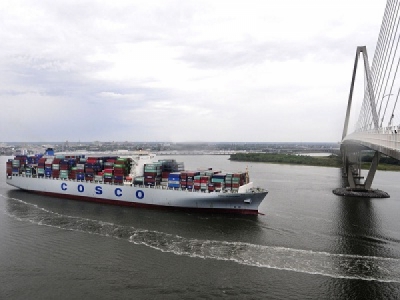
Posted on June 26, 2017
By David Wren, The Post and Courier
As the State Ports Authority prepares this month to set an annual record for containerized cargo, the maritime agency’s board of directors on Wednesday approved a budget that would set even higher marks during the coming fiscal year.
The SPA expects to finish fiscal 2017, which ends June 30, with a record 1.19 million cargo boxes moved to and from ships at the Port of Charleston. That would beat the previous annual record of 1.13 million set in fiscal 2005.
Topping that, the agency’s board approved a budget for fiscal 2018 that projects 1.26 million containers — roughly 6 percent growth over this year’s total.
To accommodate that growth, the spending plan calls for a record $278.9 million in capital expenditures over the next 12 months — much of it on improvements to the port’s North Charleston and Wando Welch container terminals.
“We’re handling volumes bigger than we’ve ever had before,” said Jim Newsome, the SPA’s president and CEO. “If you look at this year’s capital plan, it is mainly geared toward having our existing facilities ready to handle big ships. We’re just in the nick of time in that effort.”
The increased cargo is the result of growth in world trade and the trend of shipping lines using vessels that carry up to 14,000 cargo boxes at a time to call on East Coast ports. Those big ships are more common following last year’s expansion of the Panama Canal, with the Port of Charleston seeing weekly calls from the so-called post-Panamax vessels. A second weekly call is expected to be added by the end of this year.
Newsome said the next 12 months will be a “transition year” as the SPA uses a combination of debt and revenue to first shore up its existing terminals before getting its new Leatherman Terminal up and running by 2020. That terminal, which is under construction on the former Navy base in North Charleston, will boost the SPA’s capacity for containerized cargo by 50 percent at full build-out.
“It’s clear that the southeast and Gulf Coast ports are the (nation’s) fastest-growing ports, and we need to continue to be a part of that,” Newsome said. “We have a lot to do in the next year.”
While the new budget calls for another cargo record, it projects a slowdown in year-over-year growth to about 6 percent.
“Six percent growth next year is, I think, an ambitious plan based on the fact that I think the market will settle down a little bit,” Newsome said.
A new inland port along the Interstate 95 corridor in Dillon will account for $32.2 million of the SPA’s capital budget for the coming year. The facility, designed to capture freight moving on CSX Corp. trains to and from Charleston, is expected to handle a little less than 11,000 containers in the two or three months after it opens in either March or April.
A similar inland port in Greer — which opened in October 2013 — is expected to set back-to-back records this fiscal year and next, with between about 122,000 and 147,000 cargo boxes moving annually between the Upstate and Charleston on Norfolk-Southern trains.
The SPA also expects to spend $25 million on a project to deepen Charleston Harbor to 52 feet, giving the port the East Coast’s deepest navigation channel. The $525 million dredging project received final federal approval in May.
Pamela Lackey, chairman of the SPA’s board, called the year head “an extremely significant period” for the Port of Charleston.
“We are well-positioned to build upon South Carolina’s economic development successes and remain competitive in the evolving landscape of the U.S. port industry,” she said in a written statement.
Containerized cargo accounts for more than 75 percent of the SPA’s operations, and projected growth in that segment is reflected in the agency’s $251.1 million budget for fiscal 2018 — 9.4 percent higher than the current year. Operating earnings are expected to grow by 4 percent to $44.1 million.
Not all of the SPA’s cargo businesses are projected to see growth in the coming year. The number of vehicles exported to foreign countries, primarily BMWs manufactured in Greer, is expected to remain flat in fiscal 2018 and breakbulk tonnage in Charleston should rise by just 1 percent. The number of cruise ship passengers also is expected to remain steady at about 219,000 annually.
In addition to the SPA’s board meeting, representatives of the Georgia and South Carolina ports authorities met to set a budget for the $4.5 billion Jasper Ocean Terminal to be built on the Palmetto State’s side of the Savannah River.
David Posek, a SPA board member and chairman of the Jasper terminal’s board of directors, said the group approved a $6.4 million budget for the fiscal year that starts July 1. That includes money for design and legal work as well as an agreement with the Army Corps of Engineers to deepen the Savannah River section serving the facility to 47 feet.
Designed to handle cargo after ports in Charleston and Savannah reach their limits in a decade or so, the Jasper Ocean Terminal would be the nation’s largest at buildout, with capacity for 7 million cargo containers.
Source: The Post and Courier





